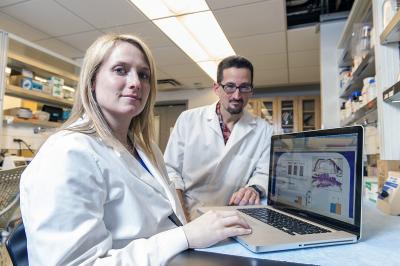Vibration may help heal chronic wounds

This is a photo of Eileen Weinheimer-Haus, first author, and Timothy Koh, principal investigator. Credit: Roberta Dupuis-Devlin/University of Illinois at Chicago Photo Services
The finding, in mice, may hold promise for the 18 million Americans who have type 2 diabetes, and especially the quarter of them who will eventually suffer from foot ulcers. Their wounds tend to heal slowly and can become chronic or worsen rapidly.
Timothy Koh, UIC professor of kinesiology and nutrition in the UIC College of Applied Health Sciences, was intrigued by studies at Stony Brook University in New York that used very low-intensity signals to accelerate bone regeneration.
“This technique is already in clinical trials to see if vibration can improve bone health and prevent osteoporosis,” Koh said.
Koh and his coworkers at UIC collaborated with Stefan Judex of Stony Brook to investigate whether the same technique might improve wound healing in diabetes. The new study, using an experimental mouse model of diabetes, is published online in the journal PLOS One.
The low-amplitude vibrations are barely perceptible to touch.
“It's more like a buzz than an earthquake,” said Eileen Weinheimer-Haus, UIC postdoctoral fellow in kinesiology and nutrition, the first author of the study.
The researchers found that wounds exposed to vibration five times a week for 30 minutes healed more quickly than wounds in mice of a control group.
Wounds exposed to vibration formed more granulation tissue, a type of tissue important early in the wound-healing process. Vibration helped tissue to form new blood vessels — a process called angiogenesis — and also led to increased expression of pro-healing growth factors and signaling molecules called chemokines, Weinheimer-Haus said.
“We know that chronic wounds in people with diabetes fail to form granulation tissue and have poor angiogenesis, and we believe these factors contribute to their wounds' failure to heal,” said Koh. He and his colleagues want to determine whether the changes they see in cell populations and gene expression at wound sites underlie the observed improvement in healing.
“The exciting thing about this intervention is how easily it could be translated to people,” Koh said. “It's a procedure that's non-invasive, doesn't require any drugs, and is already being tested in human trials to see if it's protective of bone loss.” A clinical study, in collaboration with Dr. William Ennis, director of the Wound Healing Clinic at UIC, is planned, Koh said.
Ennis and Judex are co-authors on the PLOS One study, which was supported by National Institutes of Health grants R01GM092850 and T32DE018381.
Media Contact
All latest news from the category: Health and Medicine
This subject area encompasses research and studies in the field of human medicine.
Among the wide-ranging list of topics covered here are anesthesiology, anatomy, surgery, human genetics, hygiene and environmental medicine, internal medicine, neurology, pharmacology, physiology, urology and dental medicine.
Newest articles

Bringing bio-inspired robots to life
Nebraska researcher Eric Markvicka gets NSF CAREER Award to pursue manufacture of novel materials for soft robotics and stretchable electronics. Engineers are increasingly eager to develop robots that mimic the…

Bella moths use poison to attract mates
Scientists are closer to finding out how. Pyrrolizidine alkaloids are as bitter and toxic as they are hard to pronounce. They’re produced by several different types of plants and are…

AI tool creates ‘synthetic’ images of cells
…for enhanced microscopy analysis. Observing individual cells through microscopes can reveal a range of important cell biological phenomena that frequently play a role in human diseases, but the process of…





















